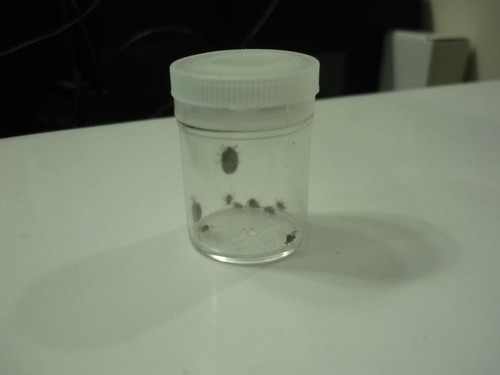
I try my best to be a responsible dog owner, and that includes ensuring that my dog gets plenty of exercise. She is quite an active dog, and spends quite a lot of time running around the house, chasing her favourite toys and just being her usual inquisitive and curious self.
I have always had this strong desire to bring her downstairs for daily walks, so that she won't be cooped up at home all the time. There is a little park close to my block, and I did have a habit of taking her for a walk through the park for between 15 minutes to half an hour every night. She gets some exercise, and a chance to socialise with other dogs. It's always great to see how happy and excited she is when she's out on these walks.
Unfortunately, I've had to stop bringing her downstairs, because of the fact that my neighbourhood is apparently infested with ticks.
It's been a problem that we've been encountering ever since she joined our family 7 years ago. There have been times when we try to walk her daily, only to stop doing so a few weeks later after we discover all the ticks hiding in her fur. Keeping her away from grassy areas doesn't seem to help; it's as if these tiny bloodsuckers home in on her the moment she sets foot on the pavement. Whenever this happens, we end up spending a great deal of time on medication and grooming, to make sure that we remove all the ticks. And of course, it means that we stop bringing my dog downstairs, so she has to make do with running around the house, and occasional trips down the corridor to meet the yappy little pomeranian two houses away.
However, this most recent episode has proven to be especially distressing, because it now seems that the ticks are breeding in my house.
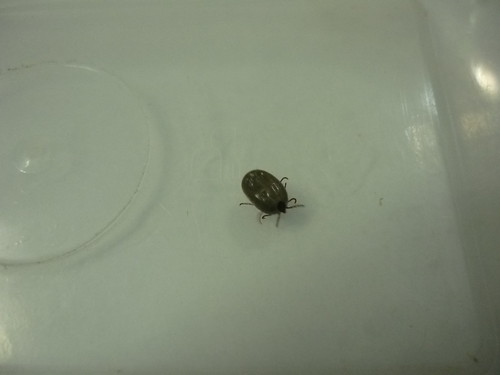
It's already been more than 2 months since the first few ticks were discovered, and since then, my dog has not gone downstairs. Yet we're still finding ticks hidden in her fur on a daily basis, so it's quite clear that the ticks have been able to lay their eggs in all the little nooks and crannies of the house.
Ticks gross me out. There's something very disturbing about the way they swell up like little blood-filled balloons after they've had a good meal. Not to mention the fact that they are important vectors for a wide variety of diseases that affect humans and domestic animals. Thank goodness Singapore is free from Lyme Disease and Rocky Mountain Spotted Fever. As if that was not bad enough, the saliva of several tick species even contains neurotoxins that can lead to Tick paralysis.
Unlike other parasites commonly found on house pets, such as fleas and mites, most tick species are unable to complete their life cycle indoors. Unfortunately, one species is capable of doing just that, the brown dog tick (Rhipicephalus sanguineus). This species is cosmopolitan, and is known to occur in Singapore. Based on the images I've been finding on the Internet, and the fact that they're breeding in my home, it's very likely that the ticks I've been finding do indeed belong to this species.
Here's some links about this species:
- Featured Creatures
- Pestproducts.com
- Urban Knowledge Master
- Tick Alert
- Green Valley Pest Control
- Illinois Department of Public Health
As its name indicates, it feeds largely on dogs (Canis lupus familiaris), although it will feed on other mammals. Humans seem to be very uncommon hosts, and considering that we haven't been finding ticks on our own bodies, I guess we're safe for now.
Although ticks cannot fly like mosquitoes, nor can they jump like fleas, they are nonetheless very good at seeking out hosts. Body heat and carbon dioxide are among the cues that ticks will use to detect prey. Hungry ticks will climb up bushes and blades of grass, and wait with their legs outstretched. If a suitable host brushes past, the tick will quickly grab on, and then crawl to a suitable spot where it can begin feeding. They can survive for extremely long periods without feeding, even up to a year, so great persistence is necessary if one is to eradicate them from the home or garden.
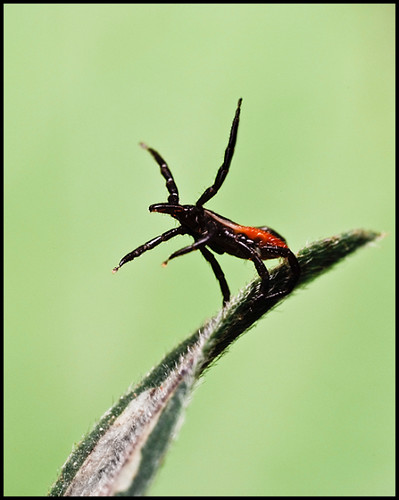
Deer tick (Ixodes scapularis)
(Photo by johnhallmen)
The brown dog tick requires 3 meals to complete its life cycle. In households that have only one dog (like mine), the same poor dog sustains every stage in the life cycle, from larvae to nymphs to adults.
After a tick has had its fill of blood, which can take a week, it will drop off and crawl away. In the case of an adult female, she will lay up to several thousand eggs, and then die shortly after. The larvae (also known as seed ticks) that hatch are tiny, and have only 6 legs. After their first meal, they drop off and then moult into 8-legged nymphs. These nymphs will then look for another meal, drop off, and finally turn into adults.
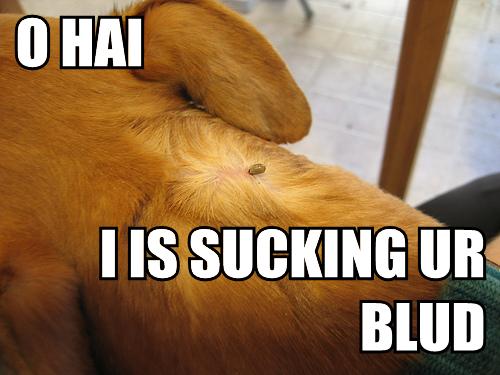
(Photo by loxosceles)
I love reading about parasites and their amazing adaptations, but it's not so pleasant when I have to deal with them on a personal basis.
I wonder if there's something about my dog that makes her especially attractive to ticks, or whether all the dogs living in my neighbourhood are also suffering from tick infestations.
Every day, we meticulously inspect my dog for ticks. It's quite easy to spot the fat grey bodies of the grossly bloated females. However, they have this annoying tendency to attach themselves to the skin between my dog's toes, and at the base of her nails. The smaller males and nymphs are much harder to find, and they crawl very quickly. It's not a good sign when we routinely manage to find ticks hiding in her fur every day, and have even spotted ticks crawling up our walls and cupboard doors. On an amusing note, my sister's teddy bear was also found to be infested with ticks, though I'm sure the ticks must have been frustrated at their inability to extract any blood.

Most of the ticks we find are gently removed, then immediately squeezed until they burst, leaving a splatter of blood and smashed tick bits on the tissue paper. It's disturbingly satisfying, especially with the engorged females; it's a lot like popping a huge pimple. I decided to keep a few alive in a small bottle out of curiosity.

It's amazing to see how long these ticks have managed to survive without food; most of these ticks have not fed for at least a month. They seem to go into a state of dormancy while waiting for their next meal. On more than one occasion, I've opened the bottle, breathed lightly on them, and watched as their seemingly lifeless bodies sprang into action and they raced for the rim of the bottle. So far, I've been quick enough to prevent any of them from escaping.
As if a bottle of ticks isn't bad enough, last week, the females started laying eggs.

I didn't take any more recent photos, but right now, there are even more eggs than what is shown in these photos.
I'm not sure if the females have finished laying, but they have been losing condition; first they started deflating, then their glossy grey bodies started developing yellowish patches. I guess they're going to die soon, once they're done laying all their eggs. I'm not so sure about the others though. I don't know if they're adult males or nymphs, but these smaller ones are definitely very feisty. In fact, they seem even more active lately; I think the hunger has gotten to them.

Needless to say, I am not a fan of the superhero known as The Tick.

Marcus has been bugging me to show them to him, so yesterday, during our TeamSeagrass monitoring session at Pulau Semakau, I passed him my bottle. To say that everyone else was extremely disgusted is an understatement. I hope he has fun trying to photograph them.
For now, the tick infestation seems to be dwindling, but we cannot afford to let our guard down. Regular baths, daily inspections, and frequent applications of Hartz® ADVANCED CARE™ 2 in 1® Flea & Tick Killer are the 3 main strategies we've adopted, and my poor dog is taking all this in her stride. I'm wondering if we need to get something more potent; Hartz® does have other anti-parasite products, I've read favourable reviews for Frontline®, and a friend just recommended Revolution®. I am a little apprehensive about the toxicity of these treatments, but at the same time, I want to get rid of these annoying little arachnids once and for all.
If you're brave enough, there's quite a lot of photos of ticks over on Flickr; there's even a group dedicated to sharing photographs of ticks.
But this has got to be one of my favourite photographs of a tick. It's disgusting, but you have to admit that it's an awesome shot, considering the size of the subject matter.
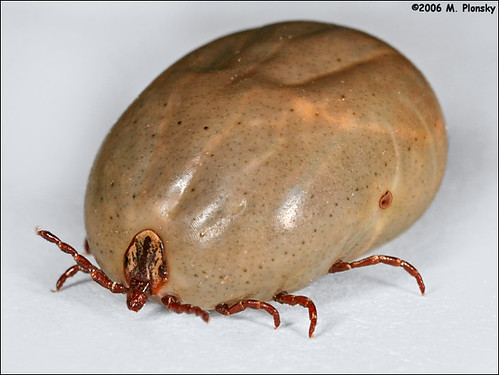
Rocky Mountain wood tick (Dermacentor andersoni)
(Photo by mplonsky)
I try my best to convince other people that every species on Earth has a vital role to play in the ecosystem, even those species that we consider pests, or those which spread life-threatening diseases. But even I have to admit that right now, I am not really a fan of ticks.